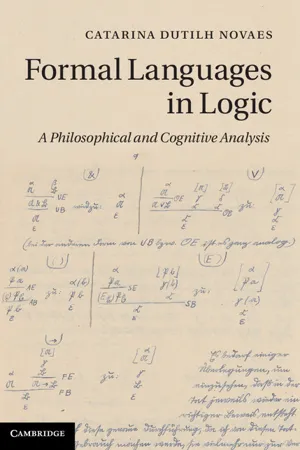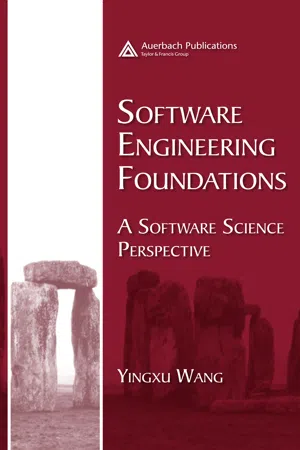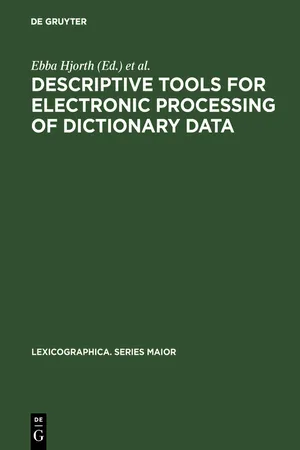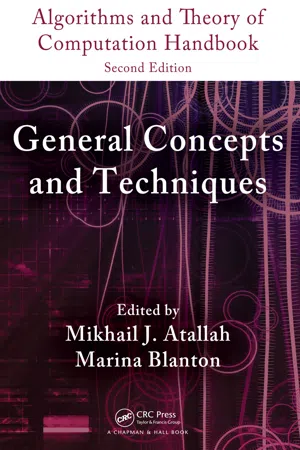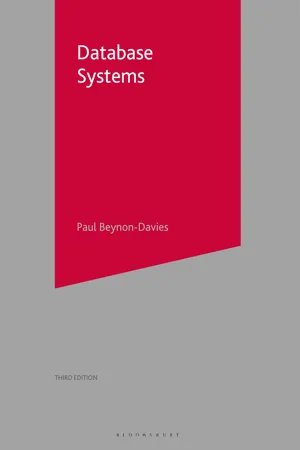Languages & Linguistics
Formal Language
Formal language refers to a precise, structured system of communication with well-defined rules and syntax. It is often used in mathematics, computer science, and linguistics for expressing ideas and algorithms in a clear and unambiguous manner. Formal languages are characterized by their rigor and lack of ambiguity, making them suitable for use in technical and scientific contexts.
Written by Perlego with AI-assistance
Related key terms
1 of 5
8 Key excerpts on "Formal Language"
- eBook - PDF
Formal Languages in Logic
A Philosophical and Cognitive Analysis
- Catarina Dutilh Novaes(Author)
- 2012(Publication Date)
- Cambridge University Press(Publisher)
Generally, many of the different variations of the formal I have discussed in Dutilh Novaes 2011b allow for degrees of being formal, in such a way that the formal v. non-formal divide would not be a sharp, clear-cut demarcation. Yet, it seems that the concept of a Formal Language is not compatible with the idea of a distinction of degrees. True enough, a language can be regimented to a greater or lesser extent, but the concept of a fully fledged Formal Language is a mathematically well-defined concept with precise borders. A structure is a Formal Language iff it is defined by a finite collection of symbols and rules of formation which determine exactly what is to count as a permissible combination of symbols, i.e., a well-formed formula of the language. (In other words, the definition of a well-formed formula is recursive with respect to the formation rules.) Thus defined, a Formal Language is a mathematical object, and its properties can be (mathematically) investigated. In practice, however, much of the work done in mathematics and in logic (both ‘pure’ and applied logic) does not really make use of fully fledged Formal Languages, using instead collections of symbolisms and notations that could perhaps be described as ‘semi-formal’. The main difference would be that in the latter case no explicit formulation of formation rules is given, or in any case not exhaustively. (In the present investigation, we are interested both in fully fledged formal and in semi- Formal Languages.) Moreover, once the class of well-formed formulas of a language is defined, rules of transformation may be specified which determine the legitimate steps from one formula to another. 28 When such rules of trans- formation and axioms are formulated in the same language, this yields a formal system or formal theory having the language in question at its basis. - eBook - PDF
Software Engineering Foundations
A Software Science Perspective
- Yingxu Wang(Author)
- 2007(Publication Date)
- Auerbach Publications(Publisher)
Every defined rule in the grammars of human languages has exceptions and their semantics depends on contexts, situations, and subjective perceptions. In contrary, Formal Languages are theories and rules for rigorously specify, analyze, generate, and recognize programming languages. Formal Language theories study the following objects hierarchically from the bottom up: 426 Part II Theoretical Foundations of SE • Alphabets • Strings • Expressions • Languages • Grammars • Machines capable to process Formal Languages Software engineering may need to extend conventional Formal Language theories from language generation and recognition to software system modeling and specification . 6.3.1 ALPHABET Any language, natural and artificial, for human or machine, is based on a set of symbols known as the alphabet. Definition 6.12 An alphabet ∑ is a nonempty finite set of symbols or letters. Example 6.1 The following sets of symbols are typical alphabets: a) Roman alphabet: ∑ R = {a, b, …, z, A, B, …, Z} b) The binary alphabet: ∑ B = {0,1} c) Digits: ∑ D = {0,1, 2, …, 9} d) Operators: ∑ OP = {+, -, *, /, :=, … } In software engineering, the alphabet of a programming language ∑ PL is usually an extension of ∑ R ∪ ∑ D ∪ ∑ OP . The alphabets of modeling and specification notation systems can be more complicated over ∑ L with extensions of special structural, architectural, and behavioral symbols. 6.3.2 STRINGS Strings are the second-level building block of a language based on a given alphabet. Definition 6.13 A string s over an alphabet ∑ is a finite sequence of symbols defined on ∑ . A string is also known as a word . Example 6.2 The following sequences are typical strings: a) A string over Roman alphabet ∑ R : s 1 = ‘Software engineering’. Chapter 6 Linguistic Foundations of SE 427 b) A string over the binary alphabet ∑ B : s 2 = ‘011’. c) An empty string over any alphabet: s 3 = ∅ , or s 3 = ‘ ’. Major string operations are length test, concatenation, and closure. - eBook - PDF
Descriptive tools for electronic processing of dictionary data
Studies in computational lexicography. Mit einer deutschen Zusammenfassung / Avec un résumé français
- Ebba Hjorth, Danske Lexikografiske Gruppe, Ebba Hjorth, Danske Lexikografiske Gruppe(Authors)
- 2017(Publication Date)
- De Gruyter(Publisher)
Similar descriptions will be important again when the contents of the database are to be presented in linear form, whether in a book, on a screen or in some other medium. The mathematical theory of Formal Languages provides a tool for the description of structure. According to the theory of aut-omata, various types of automaton correspond to the various types 119 of Formal Language. The types of automaton have properties that determine how complicated it is to construct a program that emu-lates the automaton. If one can describe dictionary structures by means of a weak formalism, one knows, by virtue of the parallel with a given type of automaton, that it is feasible to construct a program to deal with the structure. 5.2 Formal Languages Our present experience suggests that the formats of many diction-aries can be described by using concepts from the theory of con-text-free Formal Languages as a grammar with a vocabulary and re-writing rules. The grammar stipulates which strings are well-formed, i.e. are in accordance with the editorial rules. By vocabulary or alphabet, this theory means a non-null, fin-ite set of symbols. Some of these are terminal: for example, the set of characters called the alphabet in normal language would be terminals in a grammar of spelling; the limited set of stand-ard words, including inflectional forms, that are necessary and sufficient to write a weather report would be the terminals of a grammar of weather reports. In the latter case, for example, rai-ny belongs to the terminal vocabulary and cannot be further split up. In other words, the analysis stops at the terminal symbols. By a string is meant an ordered sequence of symbols from the vocabulary. If the vocabulary is the Danish alphabet, a grammar might consist of a set of rules stating which sequences of let-ters form valid Danish monosyllabic words. - eBook - PDF
Algorithms and Theory of Computation Handbook, Volume 1
General Concepts and Techniques
- Mikhail J. Atallah, Marina Blanton(Authors)
- 2009(Publication Date)
- Chapman and Hall/CRC(Publisher)
His work influenced Emil Post, Stephen Kleene, and others to study the mathematical properties of strings and collections of strings. Soon after the advent of modern electronic computers, people realized that all forms of information—whether numbers, names, pictures, or sound waves—can be represented as strings. Then collections of strings known as languages became central to computer science. This chapter is concerned with fundamental mathematical properties of languages and language-generating systems, such as grammars. Every programming language from Fortran to Java can be precisely described by a grammar. Moreover, the grammar allows us to write a computer program (called the syntax analyzer in a compiler) to determine whether a string of statements is syntactically correct in the programming language. Many people would wish that natural languages such as English could be analyzed as precisely, that we could write computer programs to tell which English sentences are grammatically correct. Despite recent advances in natural language processing, many of which have been spurred by formal grammars and other theoretical tools, today’s commercial products for grammar and style fall well short of that ideal. The main problem is that there is no common agreement on what are grammatically correct (English) sentences; nor has anyone yet been able to offer a grammar precise enough to propose as definitive. And style is a matter of taste(!) such as not beginning sentences 20 -1 20 -2 General Concepts and Techniques with “and” or using interior exclamations. Formal Languages and grammars have many applications in other fields, including molecular biology (see [17]) and symbolic dynamics (see [14]). In this chapter, we will present some formal systems that define families of Formal Languages arising in many computer science applications. Our primary focus will be on context-free languages (CFL), since they are most widely used to describe the syntax of programming languages. - eBook - PDF
Understanding Language
A Study of Theories of Language in Linguistics and in Philosophy
- (Author)
- 2019(Publication Date)
- De Gruyter Mouton(Publisher)
Natural in this context should not be contrasted with invented, and certainly not with formal. It may or may not be the case that natural languages are Formal Languages, i.e. that one can specify rigorously their syntactic and semantic structure. Again, it may or may not be the case that an invented language like Es-peranto could serve as a natural language. The sense of natural in the theoretically interesting inter-pretation of the phrase natural language is: L is a natural language if and only if it is a language that could be learned by a human (or device sufficiently like a human) as a first language under the normal learning conditions. This characterisation is vague in certain key spots: what is a device sufficiently like a human? What are the normal learning conditions? However, we shall have to rely on this notion; we cannot wait until the de-tails have been worked out. Naturalness must be tied to univer-sal acquisition conditions. It is on the assumption that language is partly a biological phenomenon, and that there are universal acquisition conditions that we can talk about the general struc-tures of language as such, in contrast to the different structures of particular languages. It is also important that our notion of what a natural language is should have empirical content, no matter how vague at present. 2.1.1. Mathematical Foundations, the Formal Power of Grammars It is commonly agreed that with the appearance of Chomsky's early work linguistics changed drastically, but the nature of the changes are not often clearly understood. In particular, it is im-portant to sort out Chomsky's conceptual proposals and his speci-fic empirical hypotheses. Among the conceptual proposals some are permanent contributions, regardless of further changes in empirical evidence that requires the formulation of new hypoth-eses about specific rules of grammar. - eBook - PDF
- Paul Beynon-Davies(Author)
- 2017(Publication Date)
- Red Globe Press(Publisher)
Work in the information systems area abounds with a variety of such Formal Languages Some of the most well-developed examples of Formal Languages are those developed in formal logic, including propositional and predicate logic. These languages are useful as ways of representing restricted universes of discourses and developing reasoning about their properties. 2.6 S C H E M A S The term universe of discourse (UoD), or domain of discourse, is sometimes used to describe a context within which a group of signs (usually linguistic terms) is used continually by a social group or groups. For work in the area of information systems it is important to develop a detailed understanding of the 24 D A T A B A S E S Y S T E M S Example All the existing programming languages such as C++ or Java are examples of Formal Languages. ➠ Example Many of the Formal Languages used to build database systems, such as structured query language (SQL) (Part 3), are founded in formal logic. ➠ structure of these terms. In database work this structure is known as a schema. A schema is an attempt to develop an abstract description of some UoD, usually in terms of a Formal Language such as logic. In classic Aristotelian logic the intension of a sign is a collection of proper-ties that may be divided into two groups: the defining properties that all phenomena in the extension must have; and the properties that the phenom-ena may or may not have. The nature of the defining properties is such that it is objectively determinable whether or not a property has certain phenomena. In classical logic, such properties are designated by predicates (Chapter 9). Hence, defining properties in this view determines a sharp boundary between membership and non-membership of a sign. A database schema is made up of a series of signs. A schema is therefore a representation of some reality. - eBook - ePub
- Hadumod Bussmann, Kerstin Kazzazi, Gregory Trauth, Kerstin Kazzazi, Gregory Trauth(Authors)
- 2006(Publication Date)
- Routledge(Publisher)
Logic in linguistics. Cambridge.Cresswell, M.J. 1973. Logics and languages. London.Feys, R. and F.Fitch. 1969. Dictionary of symbols of mathematical logic. Amsterdam.Gabbay, D.M. and F.Guenthner (eds) 1983–9. Handbook of philosophical logic, 4 vols. Dordrecht.Guttenplan, S. 1986. The languages of logic. Oxford.Hodges, W. 1983. Elementary logic. In D.M.Gabbay and F.Guenthner (eds), Handbook of philosophical logic. Dordrecht. Vol. 2, 1–131.Marciszewski, W. (ed.) 1981. Dictionary of logic as applied in the study of language: concepts, methods, theories. The Hague.McCawley, J.D. 1981. Everything that linguists have always wanted to know about logic but were ashamed to ask. Oxford.Moore, R.C. 1993. Logic and representation. Chicago, IL.Quine, W.V.O. 1950. Methods of logic. New York.Reichenbach, H. 1947. Elements of symbolic logic. New York (5th edn 1956.)Van Fraassen, B. 1971. Formal semantics and logic. New York.Wall, R. 1972. Introduction to mathematical linguistics. Englewood Cliffs, NJ.Zierer, E. 1972. Formal logic and linguistics. The Hague.Bibliographies
Partee, B., S.Sabsay, and J.Soper. 1971. Bibliography: logic and language. Bloomington. IN.Petöfi, J.S. (ed.) 1978. Logic and the formal theory of natural language: selective bibliography. Hamburg.formal meaning ⇒ lexical meaning vs grammatical meaning
formal semantics ⇒ logical semantics
formalization
Use of Formal Languages of mathematics and formal logic to describe natural languages. The advantage of formalization as opposed to nonformalized descriptions is the greater explicitness of the vocabulary (=terminology), precision and economy, as well as simpler verification of argumentation.References
Chomsky, N. and G.A.Miller. 1963. Introduction to the formal analysis of natural languages. In R.D. Luce et al. (eds), Handbook of mathematical psychology. New York. Vol. 2, 269–321.Salomea, A. 1973. Formal Languages - eBook - PDF
- Panayiota Vassilopoulou, Daniel Whistler, Panayiota Vassilopoulou, Daniel Whistler(Authors)
- 2021(Publication Date)
- Routledge(Publisher)
8 FORMAL-SYNTACTICAL THINKING AND THE STRUCTURE OF THE WORLD Paul M. Livingston It is distinctive of ‘analytic’ philosophy in the twentieth century to see traditional problems of the thinking-being relationship as, essentially, problems of the bearing of language on reality: how do the signs and structures of our finitely formulated and rationally intelligible language come to describe and characterize the facts and objects of the world, as such and as a whole? As I shall argue here, the internal development of this problematic over the course of the tradition establishes not only the specific forms in which this bearing can be rationally comprehended, but also the essential formal limits to which this comprehension is subject. The demonstration of these formally necessary limits then essentially henceforth marks the broader problematic of the thinking-being relationship, most decisively where linguistic reflection considers the im-plications of its own position within the totality of the world that it thinks. One of the most decisive innovations of analytic philosophy in its initial stages was the prospect, suggested by Wittgenstein but developed most prominently by Carnap, of under-standing rational thinking about the world as having the rule-governed formal structure of a language: the finitely tractable ‘logical syntax’ of its well-specified rules of symbolic combi-nation and transformation. A language is, on this conception, essentially a calculus: that is, a structure of signs governed by logical or syntactical rules for formation and transformation that are formal in the sense that they are empty of material content and independent of contingent facts. It is only as such that the signs of a language are, on this conception, capable at all of determinate and non-contradictory application to the description of the world, as all that is the case .
Index pages curate the most relevant extracts from our library of academic textbooks. They’ve been created using an in-house natural language model (NLM), each adding context and meaning to key research topics.
